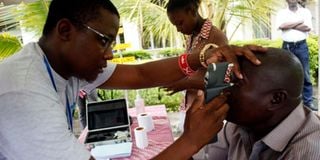Thousands to benefit from blindness prevention project

Clinical officer Hezron Waswa examines a patient's eyes in Mombasa during a past World Glaucoma Week.
What you need to know:
- Globally, at least 2.2 billion people have a near or distance vision impairment. In at least 1 billion – or almost half – of these cases, vision impairment could have been prevented or has yet to be addressed.
- The leading causes of vision impairment and blindness are uncorrected refractive errors and cataracts.
A project for blindness prevention has been launched in the country.
The ‘Integrated Eye Health Program’, which is part of an ongoing partnership to tackle avoidable blindness, aims to improve the accessibility of eye health services with a special focus on cataract, glaucoma and diabetic retinopathy.
Pharma giant Novartis Pharmaceutical, The Fred Hollows Foundation, a non-profit aid organisation, and Kenya inked the strategic investment deal to inaugurate the programme, which will educate over 400, 000 people on eye diseases and screen at least 40,000 patients, while prioritising the most vulnerable and marginalised communities.
“The Ministry of Health estimates that 15.5 per cent of Kenyans need quality eye care services, ranging from surgeries, treatments and spectacle corrections, but only about a fifth do have access to eye health services. “
“We are working to change that in partnership with The Fred Hollows Foundation and the International Agency for Prevention of Blindness (IAPB) by expanding equitable access to eye care in remote communities in Kenya,” said Dr Michael Gichangi, head of Ophthalmology at the Ministry of Health.
Globally, at least 2.2 billion people have a near or distance vision impairment. In at least 1 billion – or almost half – of these cases, vision impairment could have been prevented or has yet to be addressed. The leading causes of vision impairment and blindness are uncorrected refractive errors and cataracts. Most people with vision impairment and blindness are over the age of 50. However, vision loss can affect persons of all ages.
“In nine out of 10 cases, blindness and vision impairment can be avoided when addressed and treated early. But it all starts with educating people,” said Jane Ohuma, Country Manager, Kenya and Rwanda, The Fred Hollows Foundation.
According to the IAPB 2020 Vision Atlas report on Kenya, there were an estimated 3.9 million people with vision loss. Of these, 290,000 were blind.




